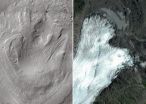(Press-News.org) 3,500 million years ago the Martian crater Gale, through which the NASA rover Curiosity is currently traversing, was covered with glaciers, mainly over its central mound. Very cold liquid water also flowed through its rivers and lakes on the lower-lying areas, forming landscapes similar to those which can be found in Iceland or Alaska. This is reflected in an analysis of the images taken by the spacecraft orbiting the red planet.
NASA’s Mars Curiosity Rover has completed a Martian year –687 Earth days– this week. The vehicle travels through an arid and reddish landscape that was home to glaciers in the past. Ancient Mars held large quantities of water, yet its global hydro-geological cycles were very cold, so much so that they induced the presence of a giant ocean, partially ice-covered and rimmed by glaciers on the lower plains of the northern hemisphere.
Now, an international team of researchers has confirmed this global picture locally, on the Martian site where Curiosity is roving: Gale crater. "This crater was covered by glaciers approximately 3,500 million years ago, which were particularly extensive on its central mound, Aeolis Mons" points to SINC the lead investigator of the study Alberto Fairén, from the Centro de Astrobiología (INTA-CSIC) in Spain and Cornell University in the USA.
"However, at that time there were also rivers and lakes with very cold liquid water in the lower-lying areas within the crater," adds the researcher, who highlights the fact that ancient Mars was capable of "maintaining large quantities of liquid water (an essential element for life) at the same time that giant ice sheets covered extensive regions of its surface".
To carry out the study, the team has used images captured with the HiRISE and CTX cameras from NASA's Mars Reconnaissance Orbiter, together with the HRSC onboard the Mars Express probe managed by the European Space Agency (ESA).
Analyses of the photographs have revealed the presence of concave basins, lobated structures, remains of moraines and fan-shaped deposits which point to the existence of ancient glaciers on Gale. In fact they seem to be very similar to some glacial systems observed on present-day Earth.
"For example, there is a glacier on Iceland –known as Breiðamerkurjökull– which shows evident resemblances to what we see on Gale crater, and we suppose that is very similar to those which covered Gale's central mound in the past," says Fairén.
The article also shows images of other glacial systems on Earth which match those on Mars, such as the Malaspina glacier (named after the famous mariner in the service of the Spanish Navy) in Alaska, or others located in northern regions of Canada and the Antarctic.
"As part of the Mars Science Laboratory (MSL) NASA mission, the Curiosity rover can still find evidence of past glacial activity on Gale, and on a very small-scale, for example finding accumulations of angular to sub-angular boulders, striated bedrock and striated boulder pavements and boulder chains," points out Fairén.
The researcher emphasizes that the current study "provides strong local support for the global 'cold and wet' model of the ancient Martian environment, which explains both the geological traces of the presence of liquid water in the past which cover the entire planet together with the climatic models which have demonstrated that Mars was never a warm planet."
In the specific case of the Gale crater, it is thought that it was excavated by the impact of a huge meteorite 3,600 million years ago and was covered by glaciers shortly afterwards.
"It is even possible that the area of impact was already covered by glaciers before the collision, and in that case the glaciers would have re-covered the recently formed crater in a very short time," says Fairén, who concludes by pointing out an interesting aspect in terms of life on the planet: "The energy delivered after the impact, combined with the ice on the surface, could have generated very interesting environments from an astrobiological point of view, like hydrothermal areas for example."
INFORMATION:
References:
Alberto G. Fairén, Chris R. Stokes, Neil S. Davies, Dirk Schulze-Makuch, J. Alexis P. Rodríguez, Alfonso F. Davila, Esther R. Uceda, James M. Dohm, Victor R. Baker, Stephen M. Clifford, Christopher P. McKay, Steven W. Squyres. "A cold hydrological system in Gale crater, Mars". Planetary and Space Science 93-94: 101–118, 2014. END
Curiosity travels through ancient glaciers on Mars
2014-06-25
ELSE PRESS RELEASES FROM THIS DATE:
Taking the 'random' out: New approach to medical studies could boost participation
2014-06-25
ANN ARBOR, Mich. — It's a classic Catch-22: Medical researchers need to figure out if a promising new treatment is truly better than a current one, by randomly assigning half of a group of patients to get each treatment.
But when they approach patients about taking part in the study, those 50-50 random odds don't sound good enough – and the study struggles to get enough volunteers. That slows down the effort to improve treatment for that condition.
Now, new research shows the promise of an approach that takes some of the "random" out of the process, while preserving ...
Women having babies later in life more likely to live longer
2014-06-25
CLEVELAND, Ohio (June 25, 2014)—Women who had their children later in life will be happy to learn that a new study suggests an association between older maternal age at birth of the last child and greater odds for surviving to an unusually old age. That's according to a nested case-control study published online today in Menopause, the journal of The North American Menopause Society (NAMS).
In this study which used Long Life Family Study data, 311 women who survived past the oldest fifth percentile of survival (according to birth cohort-matched life tables) were identified ...
Carnegie Mellon method automatically cuts boring parts from long videos
2014-06-25
PITTSBURGH—Smartphones, GoPro cameras and Google Glass are making it easy for anyone to shoot video anywhere. But, they do not make it any easier to watch the tedious videos that can result. Carnegie Mellon University computer scientists, however, have invented a video highlighting technique that can automatically pick out the good parts.
Called LiveLight, this method constantly evaluates action in the video, looking for visual novelty and ignoring repetitive or eventless sequences, to create a summary that enables a viewer to get the gist of what happened. What it produces ...
Aging with HIV and AIDS: A growing social issue
2014-06-25
TORONTO, June 25, 2014–As the first people with HIV grow old, a new study from St. Michael's Hospital questions whether the health care system and other government policies are prepared to meet their complex medical and social needs.
In high-income countries such as Canada, 30 per cent of people living with HIV are 50 or older, and many are living into their 60s and 70s. In San Francisco, more than half the people with HIV are over 50.
"It's a positive thing that people are aging with HIV," said Dr. Sean B. Rourke, a neuropsychologist who heads the Neurobehavioural ...
Advanced light source provides new look at skyrmions
2014-06-25
Skyrmions, subatomic quasiparticles that could play a key role in future spintronic technologies, have been observed for the first time using x-rays. An international collaboration of researchers working at Berkeley Lab's Advanced Light Source (ALS) observed skyrmions in copper selenite (Cu2SeO3) an insulator with multiferroic properties. The results not only hold promise for ultracompact data storage and processing, but may also open up entire new areas of study in the emerging field of quantum topology.
"Using resonant x-ray scattering, we were able to gather unique ...
Reorganization of crop production and trade could save China's water supply
2014-06-25
PRINCETON, N.J.—China's rapid socioeconomic growth continues to tax national water resources – especially in the agricultural sector – due to increasing demands for food. And, because of the country's climate and geography, irrigation is now widespread, burdening rivers and groundwater supplies.
One solution to these growing problems, however, might be to reorganize the country's crop production and trade, especially in agricultural provinces such as Inner Mongolia, Heilongjiang and Hebei, according to new report issued by Princeton University's Woodrow Wilson School ...
Collaborative learning -- for robots
2014-06-25
Machine learning, in which computers learn new skills by looking for patterns in training data, is the basis of most recent advances in artificial intelligence, from voice-recognition systems to self-parking cars. It's also the technique that autonomous robots typically use to build models of their environments.
That type of model-building gets complicated, however, in cases in which clusters of robots work as teams. The robots may have gathered information that, collectively, would produce a good model but which, individually, is almost useless. If constraints on power, ...
Are fish near extinction?
2014-06-25
"An end to seafood by 2050?" "Fish to disappear by 2050?" These sensational media headlines were the result of a 2010 report by the United Nations Environment Program, declaring that over-fishing and pollution had nearly emptied the world's fish stocks. That scarcity portends disaster for over a billion people around the world who are dependent on fish for their main source of protein.
Now, a new study by Dr. Roi Holzman and Victor China of the Department of Zoology at Tel Aviv University's George S. Wise Faculty of Life Sciences has uncovered the reason why 90% of fish ...
Fifty percent of quality improvement studies fail to change medical practices
2014-06-25
Over the last two decades, nearly half of all initiatives that review and provide feedback to clinicians on healthcare practices show little to no impact on quality of care, according to a new study by Women's College Hospital's Dr. Noah Ivers.
The study, published in the Journal of General Internal Medicine, found only 28 per cent of all studies showed an improvement of at least 10 per cent in quality of care over a 25-year period.
"Research shows there is a gap between recommended practices and the care patients actually receive," said Dr. Noah Ivers, a family physician ...
Fracking flowback could pollute groundwater with heavy metals
2014-06-25
VIDEO:
This video visualizes the effects of hydrofracking flowback fluid on colloid mobilization in unsaturated sand. Included are the injection of the colloids into the sand column at the beginning of...
Click here for more information.
ITHACA, N.Y. – The chemical makeup of wastewater generated by "hydrofracking" could cause the release of tiny particles in soils that often strongly bind heavy metals and pollutants, exacerbating the environmental risks during accidental spills, ...





